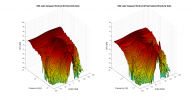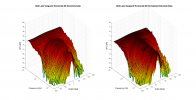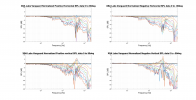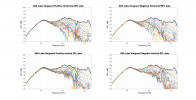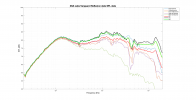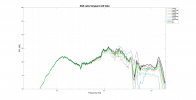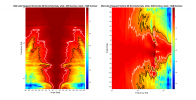This is a review, listening tests, EQ and detailed measurements of the XSA Labs Vanguard 2-way sealed speaker. It is on kind loan from a member and costs US $999 for a pair.
View attachment 300870
The bamboo version I have is machined so well that the corners are almost knife sharp! Magnetic grill is a nice touch but for testing, I removed it as you see. Not much to the back panel as to show that it is a sealed design:
View attachment 300871
Seems like the company name used to be Vera-Fi.
If you are new to my testing, please watch this tutorial on
understanding speaker measurements.
XSA Labs Vanguard Speaker Measurements
Let's start with our usual anechoic frequency response measurements created by Klippel Near-field Scanner:
View attachment 300872
Well, this is not what we want to see! We have massive and broad peaking of the response from about 700 to 3 kHz and a couple of notches. There seems to be no attempt at creating a neutral response. Sensitivity drops to a very low 80 dB or even lower at some frequencies. Company post a DIY style measurement in a forum showing something different:
View attachment 300873
While their is also pretty bad it shows that using the wrong protocol for testing can hide actual design issues.
Simple near-field driver measurements show the core problem:
View attachment 300874
Notice the wide overlap between the tweeter and woofer. The two add up to create the "hill" we see in the anechoic frequency response measurement.
The mid-woofer is close enough in size to the tweeter which makes for decent directivity. That makes it easier to EQ but without, it causes off-axis to be just as bad as on-axis:
View attachment 300932
This makes predicted-in-room response decidedly poor:
View attachment 300876
Allowing the woofer to play too high seems to be the reason for higher distortion in that region:
View attachment 300877
View attachment 300878
Digging into directivity again, we see confirmation of what I stated above:
View attachment 300879
If we didn't have that notch between 4 and 5 kHz, this would have been a pretty good response. For that reason though, you better toe in the speaker toward you:
View attachment 300880
Vertically we have to stay at tweeter axis as is typically the case with 2-way traditional designs like this:
View attachment 300881
Company spec of 8 ohm impedance seems right for the lowest it gets:
View attachment 300882
Finally, here is our waterfall and step responses:
View attachment 300883
View attachment 300884
XSA Labs Vanguard Listening Tests and Equalization
I usually start with my female vocals but this time, I had one of my bass tracks queued up so hit play on that. I was surprised how little volume I was getting out of the speaker even after I cranked it way up (I have a 400 watt Mark Levinson amplifier driving it). I stopped and switched to my regular female vocal and volume shot way up. The sound was inoffensive and one could think this is good sound (if you didn't play anything with bass in it). Recalling the poor frequency response measurements, I brought out the EQ and first filter I dialed in was for the broad excess energy in lower treble:
View attachment 300886
That pulled the female vocals back, restoring a neutral response although I could see someone just listening to female vocals liking the stock sound maybe better. To my ears, there was not much warmth so I pulled up the response in upper bass as measurements showed. That was nice but then I had some boominess on a track. I have a room mode around 105 Hz and that is where this speaker peaks as well so I pulled that down some. Now the sound was much more balanced but still not to my liking. Many of my reference tracks didn't sound good.
I remembered that in the past I have had good luck in getting more bass out of sealed cabinets by pulling up the bass response a bit. If the drivers handle it without getting distortion, the effect is like having a port but without its drawback of transmitting cabinet resonances. Indeed that was the case here with that 70 Hz filter. For the first time, I could actually get some physical sensation of bass out of the floor.
With all of these filters in place, the sound was good enough for about half of my tracks. Distortion was not audible unless I really pushed the speaker where it started to creating some ticking sounds. It was plenty loud just playing one speaker so I think you will be fine with a pair.
Conclusions
Company website is high on review quotes and low on information. But reading around it seems that the company thinks they have designed something akin to BBC LS3/5A (???). Whatever the aim was, it is a complete miss in practice. They need to up their game in measurements and spend more time performing proper AB testing using other speakers blind, or as i do, with electronic EQ.
Just listening to one speaker, especially one's own design,
is likely to lead you into a ditch and that is precisely what we have. So while I appreciate the woodworking here, the speaker itself is a miss on grounds of simple principles of designing a neutral speaker that appeals to many audiophiles.
Fortunately the rather similar sizes of the drivers makes directivity decent enough that simple EQ filtering makes a dramatic difference.
I cannot recommend the XSA Labs Vanguard speaker.
----------
As always, questions, comments, recommendations, etc. are welcome.
Any
donations are much appreciated using
: https://www.audiosciencereview.com/forum/index.php?threads/how-to-support-audio-science-review.8150/

